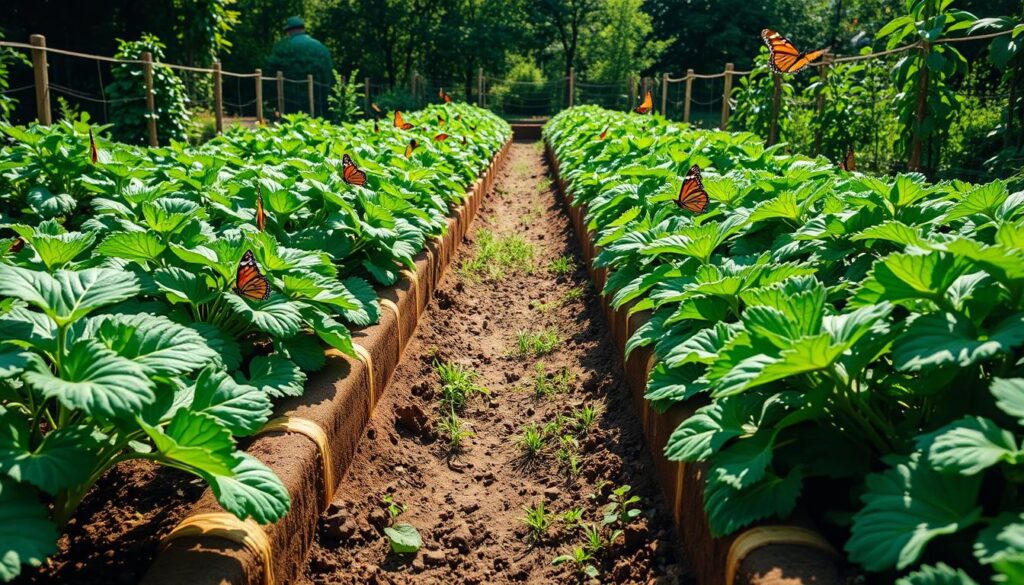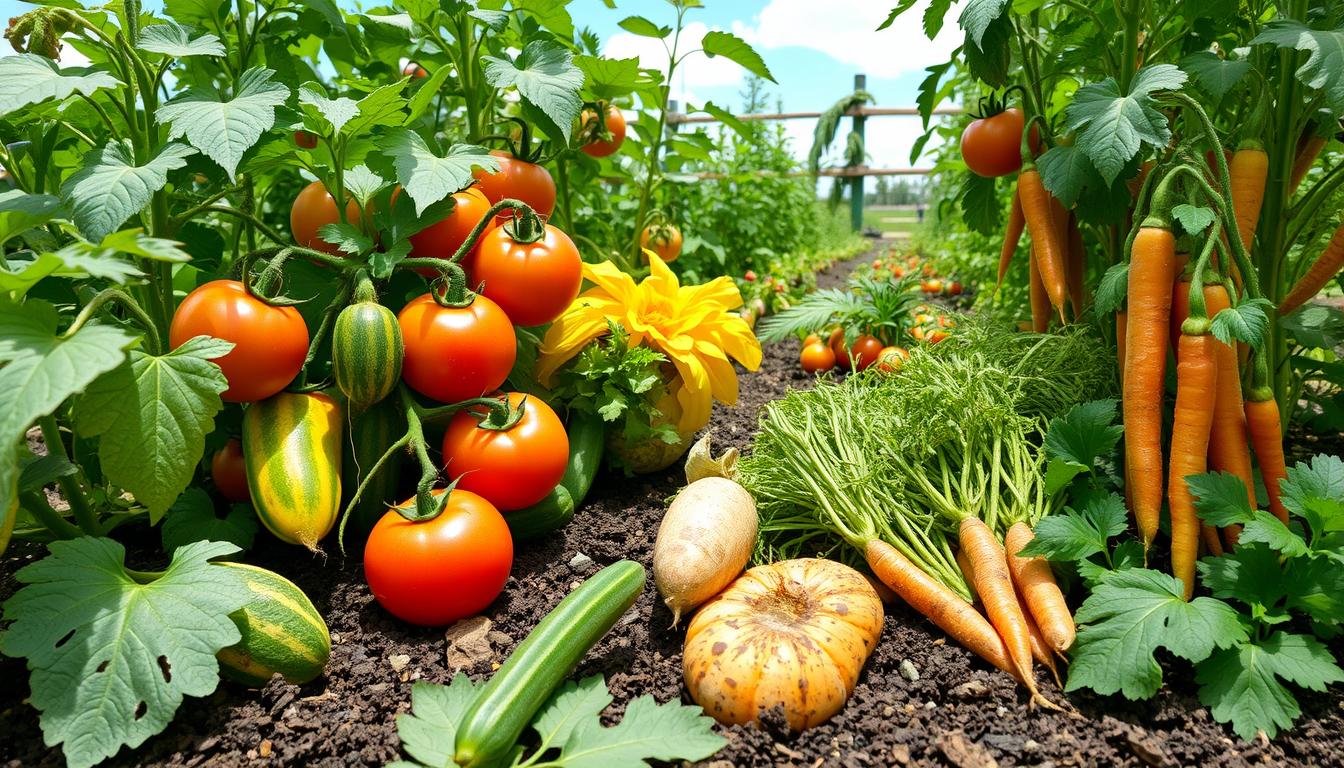Keeping your vegetable garden healthy and free from diseases is a rewarding challenge. As a seasoned horticulturist, I’m here to share my top tips. These strategies will help you prevent common diseases and ensure a healthy harvest all season.
Key Takeaways
- Learn about the most prevalent vegetable garden diseases and how to identify them early
- Discover effective prevention techniques, including crop rotation, disease-resistant varieties, and proper soil management
- Understand the importance of maintaining good air circulation and removing diseased plant material
- Explore the use of organic fungicides as a targeted treatment option
- Gain insights on promoting overall plant health and resilience in your vegetable garden
Introduction to Vegetable Garden Diseases
Gardening fans face many challenges from vegetable garden diseases. These problems include fungal infections, bacterial, and viral pathogens. They can harm our crops, reducing yields and making plants look bad. It’s key to know about these diseases and how to prevent them for a good harvest.
Importance of Disease Prevention
Preventing diseases is vital for a healthy garden. Early action can save time, money, and the sadness of losing crops. It keeps this season’s and future harvests safe by stopping pathogens and reducing disease risks.
Common Types of Vegetable Garden Diseases
Vegetable gardens face many diseases, each with its own signs and causes. Some common ones are:
- Fungal Infections – like powdery mildew, leaf spot, and root rot, which can affect many crops.
- Bacterial Diseases – such as bacterial wilt and leaf spot, which spread fast and harm plants.
- Viral Infections – including mosaic virus and cucumber mosaic virus, which stunt growth and lower yields.
- Nutrient Deficiencies – which make plants more open to disease and pests.
Knowing these common diseases helps gardeners spot and fix problems in their gardens.
“An ounce of prevention is worth a pound of cure when it comes to managing vegetable garden diseases.”
How to Prevent Common Vegetable Garden Diseases
Keeping your vegetable garden healthy is crucial for a good harvest. By using a few key strategies, you can protect your plants from diseases. Let’s look at some ways to prevent common garden diseases.
Choosing the right plants is a big step. Pick varieties that are known to resist diseases well. These plants will be more likely to thrive in your garden’s conditions.
- Try crop rotation to keep your garden healthy. Move your plants around each season. This breaks the disease cycle and keeps the soil clean.
- Keep your soil healthy with organic matter. Compost or manure help plants grow strong and fight off diseases better.
- Water your plants correctly. Give them the right amount of water at the right time. Avoid watering from above to prevent fungal diseases.
Also, get rid of any sick plants right away. This stops diseases from spreading. Make sure to dispose of them properly to avoid future problems.
By following these tips, you can have a garden full of healthy, disease-resistant plants. Remember, preventing diseases is the best way to keep your garden thriving.
Practicing Crop Rotation
Crop rotation is a proven way to stop common diseases in vegetable gardens. By planning where to put different crops, you can stop diseases from spreading. This keeps your garden healthy and full of life.
Benefits of Crop Rotation
Using crop rotation in your garden has many advantages:
- It stops soil-borne diseases by breaking their life cycle
- It makes the soil better by changing what nutrients are needed
- It lowers the number of pests and weeds that target certain crops
- It makes plants stronger and less likely to get sick
- It helps create a balanced and diverse garden ecosystem
By changing where you plant, you make it hard for diseases to find their favorite plants. This is key to keeping your garden healthy and productive.
| Crop Rotation Benefits | Description |
|---|---|
| Disease Prevention | Disrupts the life cycle of disease-causing pathogens by depriving them of their preferred host plants. |
| Improved Soil Health | Cycling different nutrient demands helps maintain a balanced soil ecosystem and fertility. |
| Pest and Weed Management | Reduces the prevalence of pests and weeds that target specific crop families. |
| Enhanced Plant Resilience | Promotes overall plant health and makes them less susceptible to diseases. |
| Biodiversity Promotion | Encourages a balanced, diverse ecosystem in your vegetable garden. |
By adding crop rotation for vegetable gardens to your routine, you can enjoy the benefits of crop rotation. This helps prevent disease and keeps your garden thriving.

Selecting Disease-Resistant Varieties
Choosing disease-resistant cultivars is key to preventing common vegetable garden diseases. These varieties are made to fight off major pathogens, fungi, and pests. They help gardeners keep their harvests thriving and healthy.
Disease-resistant vegetables are bred to have better genetic traits. This boosts their natural defense. By picking these varieties, you lower the chance of diseases like powdery mildew, tomato blight, or cucumber mosaic virus harming your garden.
To find disease-resistant vegetables, look for labels that say “resistant,” “tolerant,” or “immune” to certain diseases. Many seed companies and nurseries clearly mark these varieties. This makes it simpler for gardeners to choose wisely.
| Vegetable Crop | Disease-Resistant Varieties |
|---|---|
| Tomatoes |
|
| Cucumbers |
|
| Squash |
|
By choosing disease-resistant vegetable varieties, gardeners can greatly lower disease risks. They can enjoy a rich, healthy harvest every season.
Maintaining Proper Soil Health
Healthy, nutrient-rich soil is key to stopping vegetable garden diseases. Good soil health means a strong, disease-free garden. By knowing the value of soil nutrients and testing it often, you can fix any issues. This makes your plants grow well and fight off diseases.
Importance of Soil Nutrients
Soil in your garden is more than dirt. It’s a world full of nutrients your plants need to grow strong. Nutrients like nitrogen, phosphorus, and potassium are crucial for plant health and fighting off diseases. Without the right balance, plants can grow poorly and get sick easily.
Soil Testing and Amendments
Testing your soil regularly is vital for a healthy garden. Soil testing kits show if your soil lacks nutrients. Then, you can add organic stuff like compost or special fertilizers. This helps your soil support strong, disease-resistant plants.
- Conduct soil tests annually to monitor nutrient levels
- Add organic matter like compost to improve soil structure and fertility
- Choose slow-release, balanced fertilizers to provide a steady supply of nutrients
- Avoid excessive use of synthetic fertilizers, which can disrupt soil health
By keeping your soil healthy with regular tests and the right fixes, you set up a garden that fights off diseases. Taking care of your soil is a smart move to prevent garden diseases and get a big harvest.
Proper Watering Techniques
Keeping a vegetable garden healthy needs careful watering. Proper watering techniques help prevent diseases and make plants grow well. Here, I’ll give you tips on watering techniques for disease prevention, avoiding overwatering, and proper irrigation for vegetable gardens.
Knowing your soil type is key to good watering. Sandy soils need more water because they drain fast. Clay soils hold water longer but can get too wet. It’s important to watch how much rain your garden gets to avoid too much water.
- Water your vegetable garden in the early morning or late afternoon to minimize evaporation loss.
- Use a soaker hose or drip irrigation system to deliver water directly to the roots, reducing the risk of foliage disease.
- Adjust your watering schedule based on the specific needs of your plants, such as newly planted seedlings or established crops.
| Watering Technique | Benefits |
|---|---|
| Drip Irrigation | Delivers water directly to the root zone, reducing evaporation and disease risk |
| Soaker Hoses | Slowly and evenly distributes water, minimizing soil compaction and runoff |
| Hand Watering | Allows for targeted watering of individual plants, but can be time-consuming |
Using these watering methods can stop many diseases in vegetable gardens. It also makes sure your plants get the right amount of water to grow well.
“Proper watering is essential for a healthy, productive vegetable garden. Neglecting this crucial aspect can lead to a host of problems, from disease to poor growth.”
Removing Diseased Plant Material
Keeping your vegetable garden healthy means watching for and quickly removing sick plants. This step stops diseases from spreading, keeping your garden healthy. By acting fast, gardeners can fight off common diseases and save their crops.
Identifying Diseased Plants
First, you need to spot sick plants. Look for signs like color changes, wilting, spots, or lesions on leaves, stems, or fruits. Regular checks can catch diseases early. Knowing about common garden diseases helps you figure out what’s wrong.
If you’re not sure, ask a local gardening expert or extension office. They can help you find the disease and suggest how to treat it.
- Check plants often for signs of sickness.
- Learn about common garden diseases to diagnose better.
- Get help from experts if you’re not sure about a disease.
Removing and Disposing of Diseased Plant Material
After spotting sick plants, remove them quickly and correctly. Cut or pull the sick parts carefully, without touching healthy plants. Use different tools and hands for each to avoid spreading disease.
Get rid of the sick plants safely. Burning or bagging them for the landfill works well. Don’t compost them, as diseases can survive and harm future crops.
- Remove sick plants carefully, without touching healthy ones.
- Dispose of them by burning or bagging for the landfill.
- Don’t compost sick plants, as diseases can survive.
By quickly finding and removing sick plants, gardeners can keep their gardens healthy and fight off diseases. This is key to managing diseases in your garden.
Using Organic Fungicides
Preventing diseases in your vegetable garden is key. But sometimes, you might need organic fungicides for tough cases. Luckily, there are many eco-friendly options to fight plant diseases without harming your garden.
Types of Organic Fungicides
Organic fungicides are safe for you and your plants. They come in several types:
- Copper-based fungicides – Copper stops fungal growth naturally.
- Sulfur-based fungicides – Sulfur has been fighting garden diseases for centuries.
- Neem oil – From the neem tree, it stops fungal spores from growing.
- Bacillus subtilis – This good bacteria fights off harmful fungi in the soil and on plants.
Always read and follow the instructions on organic fungicides. These products help keep your garden healthy and disease-free.
“Using natural, organic fungicides is a great way to control plant diseases while maintaining a healthy, sustainable garden ecosystem.”
Promoting Air Circulation
Good air circulation in your vegetable garden is key to stopping disease spread. By smartly laying out and designing your garden, you can boost airflow. This helps lower disease outbreak risks.
Choosing the right plant spacing is a big step. Too close together, plants block air, creating a damp spot perfect for disease. Make sure plants have enough room for air to flow freely.
Also, how you orient your garden beds matters. Beds facing north-south get more wind. This wind dries out leaves and stops moisture buildup, which diseases love.
| Layout and Design Strategies | Benefits for Air Circulation |
|---|---|
| Proper plant spacing | Allows for better air movement around plants, reducing disease risk |
| North-south orientation of garden beds | Maximizes exposure to winds, promoting drier conditions |
| Incorporating trellis or support structures | Elevates plants, improving airflow underneath |
Using trellis or support structures is another smart move. It lifts plants up, letting air flow under them. This stops moisture from building up and diseases from growing.
With these design tips, you can make your garden a healthier place. Better air flow means fewer diseases and happier plants.

Conclusion
Preventing common vegetable garden diseases is key to a healthy harvest. By using crop rotation, choosing disease-resistant plants, and keeping soil healthy, gardeners can fight many diseases. Organic fungicides also play a big role in keeping gardens safe.
We’ve seen how knowing about different diseases is important. By creating a healthy environment, gardeners can lower disease risks. This ensures their gardens thrive for years.
Keep watching your garden for disease signs and act fast if you see any. This guide will help you keep your garden vibrant and disease-free. Enjoy a bountiful harvest every season.



Leave a Reply